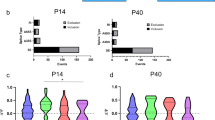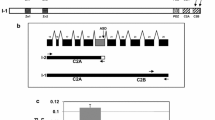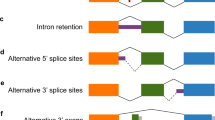Abstract
The KIAA0319 gene in chromosome 6p22 has been strongly associated with developmental dyslexia. In this article we show a wide expression pattern of this gene in human adult brain by Northern blot analysis. We also performed RT-PCR analysis to detect alternative splicing variants in human brain. Most of the detected variants involve alternative splicing of the exons at the 5′ and the 3′ ends. Two main forms differing in the length of the 5′ UTR are detected at approximately the same rate. Two variants (B and C) lacking exon 19, which encodes the transmembrane domain, are the main alternative forms detected among those predicted to encode protein. These two variants could be secreted and might be involved in signaling functions. A similar RT-PCR analysis performed in mouse and rat adult brains showed that only some of the alternative splicing variants are equivalent to those found in the human gene.




Similar content being viewed by others
References
Cope N, Harold D, Hill G, Moskvina V, Stevenson J, et al. (2005) Strong evidence that KIAA0319 on chromosome 6p is a susceptibility gene for developmental dyslexia. Am J Hum Genet 76:581–591
Fisher SE, Francks C (2006) Genes, cognition and dyslexia: learning to read the genome. Trends Cogn Sci 10:250–257
Francks C, Paracchini S, Smith SD, Richardson AJ, Scerri TS, et al. (2004) A 77-kilobase region of chromosome 6p22.2 is associated with dyslexia in families from the United Kingdom and from the United States. Am J Hum Genet 75:1046–1058
Galaburda AM, LoTurco J, Ramus F, Fitch RH, Rosen GD (2006) From genes to behavior in developmental dyslexia. Nat Neurosci 9:1213–1217
Ghashghaei HT, Lai C, Anton ES (2007) Neuronal migration in the adult brain: are we there yet? Nat Rev Neurosci 8:141–151
Guo J, Chen S, Huang C, Chen L, Studholme DJ, et al. (2004) MANSC: a seven-cysteine-containing domain present in animal membrane and extracellular proteins. Trends Biochem Sci 29:172–174
Habib M (2000) The neurological basis of developmental dyslexia: an overview and working hypothesis. Brain 123 Pt 12:2373–2399
Harold D, Paracchini S, Scerri T, Dennis M, Cope N, et al. (2006) Further evidence that the KIAA0319 gene confers susceptibility to developmental dyslexia. Mol Psychiatry 11:1085–1091
Hughes TA (2006) Regulation of gene expression by alternative untranslated regions. Trends Genet 22:119–122
Ibraghimov-Beskrovnaya O, Bukanov NO, Donohue LC, Dackowski WR, Klinger KW, et al. (2000) Strong homophilic interactions of the Ig-like domains of polycystin-1, the protein product of an autosomal dominant polycystic kidney disease gene, PKD1. Hum Mol Genet 9:1641–1649
Lejeune F, Maquat LE (2005) Mechanistic links between nonsense-mediated mRNA decay and pre-mRNA splicing in mammalian cells. Curr Opin Cell Biol 17:309–315
Londin ER, Meng H, Gruen JR (2003) A transcription map of the 6p22.3 reading disability locus identifying candidate genes. BMC Genomics 4:25
McGrath LM, Smith SD, Pennington BF (2006) Breakthroughs in the search for dyslexia candidate genes. Trends Mol Med 12:333–341
Mignone F, Gissi C, Liuni S, Pesole G (2002) Untranslated regions of mRNAs. Genome Biol 3, reviews0004
Ming GL, Song H (2005) Adult neurogenesis in the mammalian central nervous system. Annu Rev Neurosci 28:223–250
Paracchini S, Thomas A, Castro S, Lai C, Paramasivam M, et al. (2006) The chromosome 6p22 haplotype associated with dyslexia reduces the expression of KIAA0319, a novel gene involved in neuronal migration. Hum Mol Genet 15:1659–1666
Stamm S, Ben-Ari S, Rafalska I, Tang Y, Zhang Z, et al. (2005) Function of alternative splicing. Gene 344:1–20
Wagner E, Lykke-Andersen J (2002) mRNA surveillance: the perfect persist. J Cell Sci 115:3033–3038
Williams J, O’Donovan MC (2006) The genetics of developmental dyslexia. Eur J Hum Genet 14:681–689
Acknowledgments
This work was supported by the Wellcome Trust. APM is a Wellcome Trust Principal Research Fellow.
Author information
Authors and Affiliations
Corresponding author
Electronic supplementary material
Rights and permissions
About this article
Cite this article
Velayos-Baeza, A., Toma, C., da Roza, S. et al. Alternative splicing in the dyslexia-associated gene KIAA0319 . Mamm Genome 18, 627–634 (2007). https://doi.org/10.1007/s00335-007-9051-3
Received:
Accepted:
Published:
Issue Date:
DOI: https://doi.org/10.1007/s00335-007-9051-3




